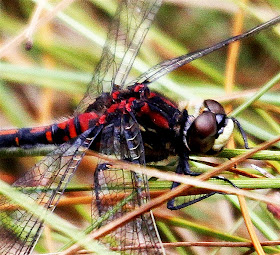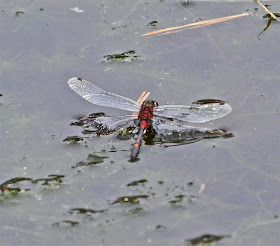White-faced Darters (Leucorrhinia dubia) are rare in the UK and considered threatened, mainly due to loss of habitat. They occur at only a few sites in England although they are rather more frequent in the Scottish Highlands. Their typical habitat is small peaty bog pools with Sphagnum in open acidic heathland.
.jpg)
A recent visit to a site in Cumbria in less than ideal, dull, breezy conditions resulted in at least six separate individuals being seen, most of them males although no doubt there would be many more concealed nearby. In dull light with the sun overcast, they remained hidden near the pools amongst the adjacent heather but as soon as a brief shaft of sunlight appeared, they were active. On this site there are several old, man-made, water-filled peat cuttings and it was at these that they were found.
.jpg)
.jpg)
.jpg)
.jpg)
The males (all photos above) are mainly black with dark red markings on the abdomen and thorax whereas in the females (below) the red colouration is replaced by yellow. Both sexes have a conspicuous white face contrasting with the dark body and from this the common name is derived. They are fast fliers but are more predictable to follow in the air than the Four-spotted Chasers which were also nearby
.jpg)
[Female]
On one occasion a White-faced Darter settled for a short time on the water surface over submerged Sphagnum as though ovipositing (below) but when viewed more closely it was found to be a male. This seemed rather strange behaviour but perhaps the male was investigating a suitable egg-laying site because in this species very specific requirements for this process have apparently to be met.
.jpg)
The habitat here comprised peaty mossland with a few small pools scattered amongst regenerating conifers with an abundance of heather
.jpg)
No comments:
Post a Comment